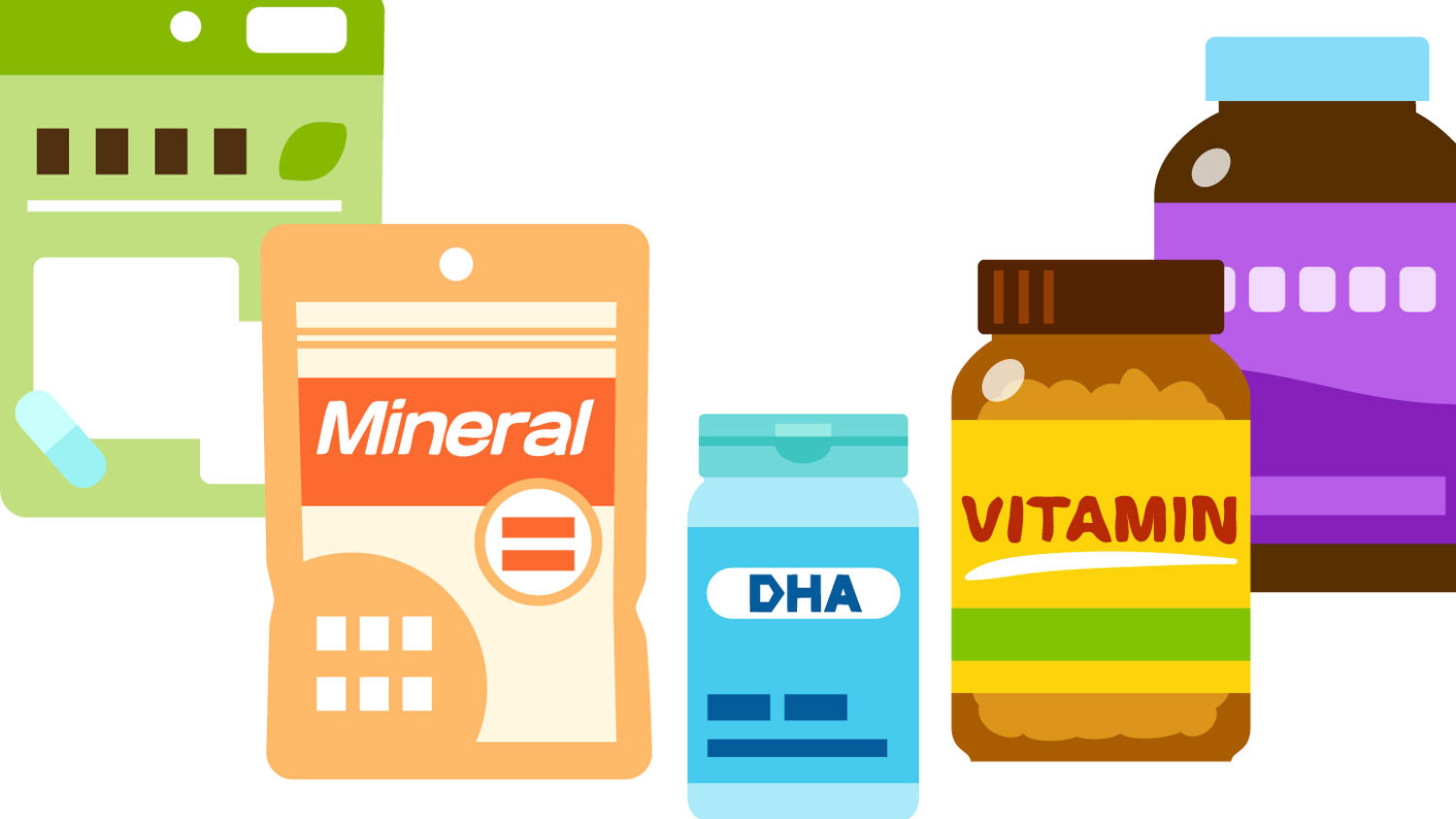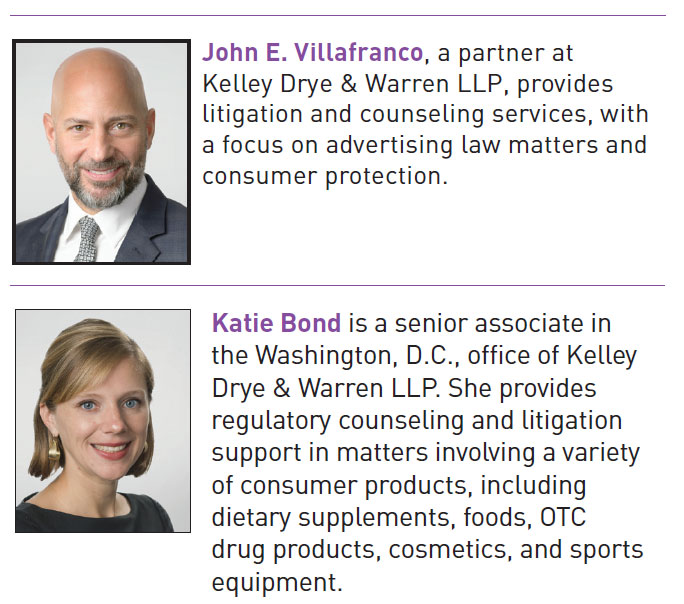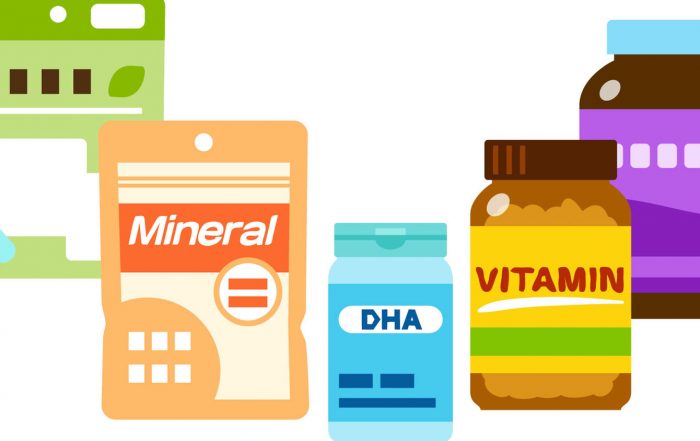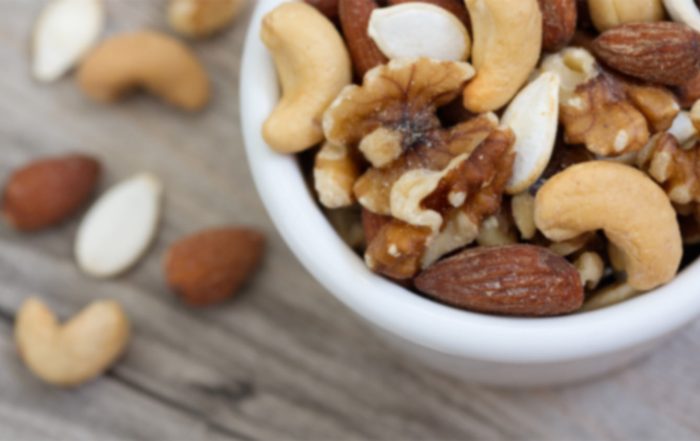
The NAD: A Force in Shaping Food and Dietary Supplement Advertising
by John E. Villafranco and Katie Bond
Governed by the Advertising Self-Regulatory Council (ASRC) and administered by the Council of Better Business Bureaus (CBBB), the NAD (National Advertising Division) was formed in 1971 to promote truthfulness and accuracy in national advertising. With a staff of attorneys based in New York City, the NAD reviews complaints filed by competitors and consumers, and through its monitoring program, identifies advertising that it believes warrants review. NAD attorneys determine whether the advertising at issue is substantiated and, if not, recommend that claims be discontinued or modified. NAD rules do not allow for formal discovery; however, each side will brief its case and have the opportunity to meet with the attorney handling the case.
The NAD process remains confidential until publication of a final case report. Each decision summarizes the position of the advertiser and challenger (if there is a challenger), and states the NAD’s conclusions based on relevant law. The NAD reviews around 100 cases per year, and the entire process, from filing to resolution, is intended to move more quickly (approximately 60 days to decision) and to be less expensive than private litigation.
Participation in the NAD process is voluntary. However, if a challenged advertiser declines to participate or fails to comply with a decision, the NAD may refer the case to an appropriate regulatory agency. Most commonly, the NAD refers cases to the Federal Trade Commission (FTC), but the Food and Drug Administration (FDA) and other agencies also receive referrals. FTC staff and Commissioners have been consistent and vocal supporters of the NAD, often noting that the NAD allows FTC to spend less time on general industry supervision and to devote its resources elsewhere.1
With support from federal rgulators, the NAD is a force in shaping advertising for a variety of consumer goods, including FDA-regulated products. Foods—and in particular, dietary supplements—are frequently the subject of NAD reviews. In the past year, the NAD has handled nine cases on conventional foods and beverages, and 26 cases on dietary supplements.2 Below are examples of cases from the past year that illustrate topics of interest in food and supplement advertising and recent developments in NAD procedures.
NAD and Competitors Focus in on Cognitive Function Claims
In the past year, the NAD has heard four cases involving products promoted with cognitive function claims. The following summaries of two of the cases highlight the types of products and claims that have tended to draw challenges.
In the first case, as part of its regular monitoring, the NAD investigated advertising claims for a cognitive function supplement.3 The challenged claims included descriptions such as the following:
IMPROVED MEMORY. The ingredients . . . have been shown to help increase memory recall in men and women of just about all ages. Men and women in their early twenties to late thirties started noticing significant increases in their short term memory and some increases in long term memory recall where people from 40 to the age of 65 noticed drastic increases in both.
The NAD closed the case without formal review after the advertiser agreed to permanently discontinue the claims.
In the second case, the seller of a cognitive function supplement challenged claims by a competitor.4 The challenger argued that the competitor’s product included doses of ingredients below what had been shown in studies to provide cognitive function benefits. Given the alleged low dosing, the challenger contended that the advertiser lacked substantiation for claims, like “Improve your memory and focus with Cognitine!” The advertiser responded to the challenge by apprising the NAD that it had closed its business and taken down its product website prior to the challenge. The NAD closed the case.
The relatively high number of NAD cases on cognitive function claims is consistent with recent FTC enforcement. From 2000 through 2013, FTC brought only one action on cognitive function claims. Since the beginning of 2014, it has taken action in five instances. As the two NAD cases illustrate, claims to improve memory or focus tend to draw more attention than more general claims like “promotes brain health” or “support for healthy brain function.” This is the case in both NAD and FTC matters.
The NAD May Accept a Clinical Study, but Reject “Clinically Proven” Claims
When the NAD investigated advertising for a dietary supplement marketed for joint health, it illustrated this point.5 The advertiser had promoted its product with claims such as, “FlexSure has been clinically proven to be effective and safe” and “Clinical trials showed that FlexSure users had significant increases in joint comfort, mobility and flexibility.” In support of these claims, the advertiser offered an eight-week randomized, multi-center, placebo-controlled, double-blind study conducted on the product in India. The study included 76 participants. To test efficacy, the study used measures including the Western Ontario and McMaster Universities Arthritis Index (WOMAC), a visual analog scale for pain, and an assessment of the use of rescue medication. While total WOMAC scores showed overall improvement, results on other measures were mixed. The NAD found that the advertiser could make narrowly tailored claims for safety and efficacy based on the positive study results. The NAD, however, recommended that the advertiser discontinue all “clinically proven” claims given that not all study results were positive and, in the NAD’s view, other studies offered by the advertiser lacked either sufficient reliability or sufficient relevance to the product (e.g., an adequate match between the product and the formulations tested).
Both the NAD and FTC take a hard line on “establishment claims,” which are claims that convey that a fact has been scientifically established or proven. Both entities take the position that an establishment claim may be conveyed by express statements, like “clinically proven,” or imagery such as medical symbols or charts depicting study results.6 Where an establishment claim is found, the NAD and FTC typically expect at least one—and often two—well-designed studies as support.
NAD Slashes Weight-Related Claims for Green Tea and Caffeine
As part of its regular monitoring, the NAD reviewed labeling and advertising claims for Mega-T Green Tea Fat Burning Supplements.7 The NAD requested substantiation for numerous claims including the following:
- “Now Mega-T has an advanced system that combines probiotics with clinically effective green tea to help you achieve your weight loss goals”;
- “Green Tea helps promote ‘good bacteria’ and burn fat”; and
- “Green Tea: Curb appetite and improve fat metabolism.”
The advertiser chose to discontinue most of the claims, which it explained had been used by a prior owner of the Mega-T brand. However, the advertiser defended claims that its product helps consumers “boost metabolism” and “burn fat.”
The NAD reviewed the underlying research and held that short-term, single-day studies offered by the advertiser failed to support the “broad, unqualified ‘boosts metabolism’ claim.” The NAD noted, however, “that nothing in [the] decision prevents the advertiser from making a carefully tailored claim that more closely matches the evidence in the record, namely the short-term nature of the recorded metabolism benefit.” The NAD rejected the “burn fat” claim after finding that various meta-analyses reached only tentative conclusions about the potential effects of green tea and caffeine for fat loss. The NAD also noted that many of the positive studies that were offered were conducted in Asia or tested only people who regularly consumed 300 mg or less caffeine per day.
One wonders if, in this case, the NAD sets the bar so high that it deprives consumers of useful dietary information. Under well-settled law, determining whether advertising substantiation is adequate depends on weighing factors such as the type and specificity of the claim, the type of product, and the potential consequences if a claim is false. Such factors would seem to weigh in favor of allowing simple, unadorned “boost metabolism” claims and qualified fat and weight-related claims that are commensurate with the conclusions of the meta-analyses. The NAD, in past cases on green tea and caffeine products, has allowed such claims.8
NAD Cases Can Close in Three Ways
Two other dietary supplement cases, which were closed in the past year, illustrate two longstanding NAD mechanisms for closure.
(1) Where advertiser permanently discontinues claims prior to case initiation: The first case involved advertising for Cellfood.9 The NAD, as a part of its routine monitoring, inquired about claims, such as the following: “By adding 24 drops of Cellfood to your water bottle each day, you’ll clean and detoxify, help to eliminate free radicals and bring oxygen, hydrogen and plant nutrients into your body.” The advertiser, in response to the inquiry, informed the NAD that it had permanently discontinued the identified claims prior to the initiation of the case. Thus, according to its rules, the NAD closed the case entirely. This means that no compliance proceedings will be possible, although an entirely new case could be filed if the same advertising claims were revived.
(2) Where the advertiser discontinues claims during NAD case review: The second closed case involved advertising for Junior
Slim, a product promoted to help manage overeating in children.10 The NAD inquired about claims, such as, “Addresses the tendency to comfort eat” and “Maintains healthy energy levels through nutrient absorption.” During the pendency of the case, the advertiser committed to discontinuing the claims. In this instance, although the NAD did not issue a formal decision assessing the claims, it stated that it would treat the claims, “for compliance purposes, as though the NAD recommended their discontinuance and the advertiser agreed to comply.” This is the manner in which the NAD routinely proceeds if an advertiser discontinues claims during, rather than before, a case begins. With this type of closure, the NAD could later bring a compliance review.
In February of this year, the NAD revised its procedural rules to create a new mechanism for closure of a case.11 The parties may reach a settlement and agree to notify the NAD in writing of their consent to close the case. Similar to the situation where claims are discontinued prior to initiation of a case, a case closed on consent of the parties will be closed entirely, without the opportunity for compliance review. However, once again, nothing in the rules bars the filing of an entirely new case if the advertiser continues to disseminate—or later revives—the same claims. A new filing fee would be required, though. Challengers who agree to settle are well-advised to consider requiring, as part of a settlement agreement, that the advertiser pay the new filing fee should a new challenge on the same claims become necessary.
Supplement Case Highlights Changes Needed to an NAD Admissibility Rule
A dietary supplement trade association, the Council for Responsible Nutrition (CRN), filed an NAD challenge against the sellers of ionDEFENDER dietary supplement.12 The advertising at issue included claims that the supplement will boost superoxide dismutase (SOD) in the body, reduce oxidative stress, and provide protection against radiation. The NAD recommended discontinuation of almost all of the claims.
In support of claims to boost SOD levels, the advertiser had offered two studies testing the effects of the primary ingredient in its product on blood levels of SOD. The NAD concluded that the studies were inadequate given that they were described only in short abstracts and appeared to have methodological flaws, such as a lack of between-group statistical analysis.
With these findings, the case highlights an ongoing issue with the NAD rules. Specifically, in any compliance proceeding, the NAD prohibits new evidence related to the claims that were reviewed. That means that even if this advertiser takes into consideration the NAD’s findings on its SOD studies and conducts a reanalysis of its data or creates more formal and complete study reports, those materials will not be admissible. With this admissibility rule, the NAD effectively bars future claims that may be entirely truthful and reflect a company’s diligence in responding to NAD criticisms.
Over a year ago, an ABA working group reviewed the NAD’s procedures and recommended changes to various rules, including this admissibility rule.13 Although the NAD has integrated other recommendations, no changes have yet been made to this admissibility rule.
Conclusion
As this sampling of cases from the past year illustrates, the NAD’s cases often parallel FTC activity in terms of what types of claims are receiving scrutiny and how the claims will be assessed. Thus, being aware of NAD precedent helps companies assess risk in developing products and new marketing campaigns. Being aware of changes in the NAD’s procedures likewise helps companies stay nimble in gauging when to challenge a competitor and how best to respond in the event of a challenge to their own advertising.
- See, e.g., FTC Staff Closing Letter to Shredlage, LLC and CLAAS of America (Sept. 13, 2016), https://www.ftc.gov/system/files/documents/public_statements/985763/shredlage_resolution_letter.pdf (“The FTC fully supports the NAD’s self-regulatory process, and we appreciate your referral and the opportunity to continue to assist in supporting the NAD.”); J. Thomas Rosch, FTC Commissioner, Remarks Before the NAD Annual Conference 2008: Self-Regulation and Consumer Protection: A Complement to Federal Law Enforcement (Sept. 23, 2008), http://www.ftc.gov/speeches/rosch/080923Rosch-NADSpeech.pdf.
- The high number of dietary supplement cases stems in part from an initiative funded by the dietary supplement trade association, the Council for Responsible Nutrition (CRN). See http://www.crnusa.org/NAD/. CRN provides funding to help the NAD bring challenges against dietary supplement advertising. CRN is also a regular challenger at the NAD.
- See BrainFire, NAD Case No. 5914 (Dec. 2015).
- See Legacy Labs, LLC, NAD Case No. 5982 (Aug. 2016).
- See Vital G-Netics/SBB Holdings, Inc., NAD Case No. 5912 (Dec. 2015).
- See, e.g., Sterling Drug v. FTC, 741 F.2d 1146, 1156 (9th Cir. 1984) (a “serious tone” and “scientific aura,” including depictions of scientific or medical reports, “implied scientific approval of the product”); POM Wonderful, LLC v. FTC, 777 F. 3d 478, 492 (D.C. Cir. 2015) (“invok[ing] medical symbols, referenc[ing] publication in medical journals, and describ[ing] the substantial funds spent on medical research, fortif[ied] the overall sense that the referenced clinical studies establish the claimed benefit”).
- See Mega-T, LLC, NAD Case No. 5952 (May 2016).
- See, e.g., WellNx Life Sciences, Inc., NAD Case No. 4876 (July 2008); Irwin Naturals, NAD Case No. 4725 (Oct. 2007).
- See NuScience Corp., NAD Case No. 5931 (Feb. 2016).
- See Silver Star Brands, NAD Case No. 5918 (Jan. 2016).
- See NAD CARU NARB Procedures (Feb. 1, 2016), http://www.asrcreviews.org/wp-content/uploads /2012/04/NAD-CARU-NARB-Procedures-Final-02-01-16.pdf.
- See Advanced Nutritional Innovations, Inc., NAD Case No. 5959 (May 2016).
- See ABA Section of Antitrust Law, Self-Regulation of Advertising in the United States: An Assessment of the National Advertising Division (Apr. 2015), http://www.kelleydrye.com/news/press_releases/2345/_res/id=Files /index=0/SELF-REGULATION%20OF%20ADVERTISING%20IN%20THE%20UNITED%20STATES.pdf; see also MCC Interview of John E. Villafranco: Ad Cops After Four Decades, Metropolitan Corporate Counsel (June 2015), http://www.kelleydrye.com/publications/articles/1963/_res/id=Files/index=0/Ad%20Cops%20 After%20Four%20Decades.pdf.
Update Magazine
November/December 2016









